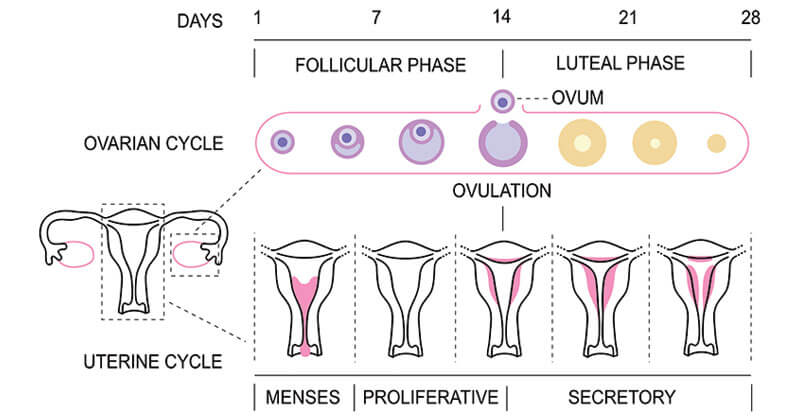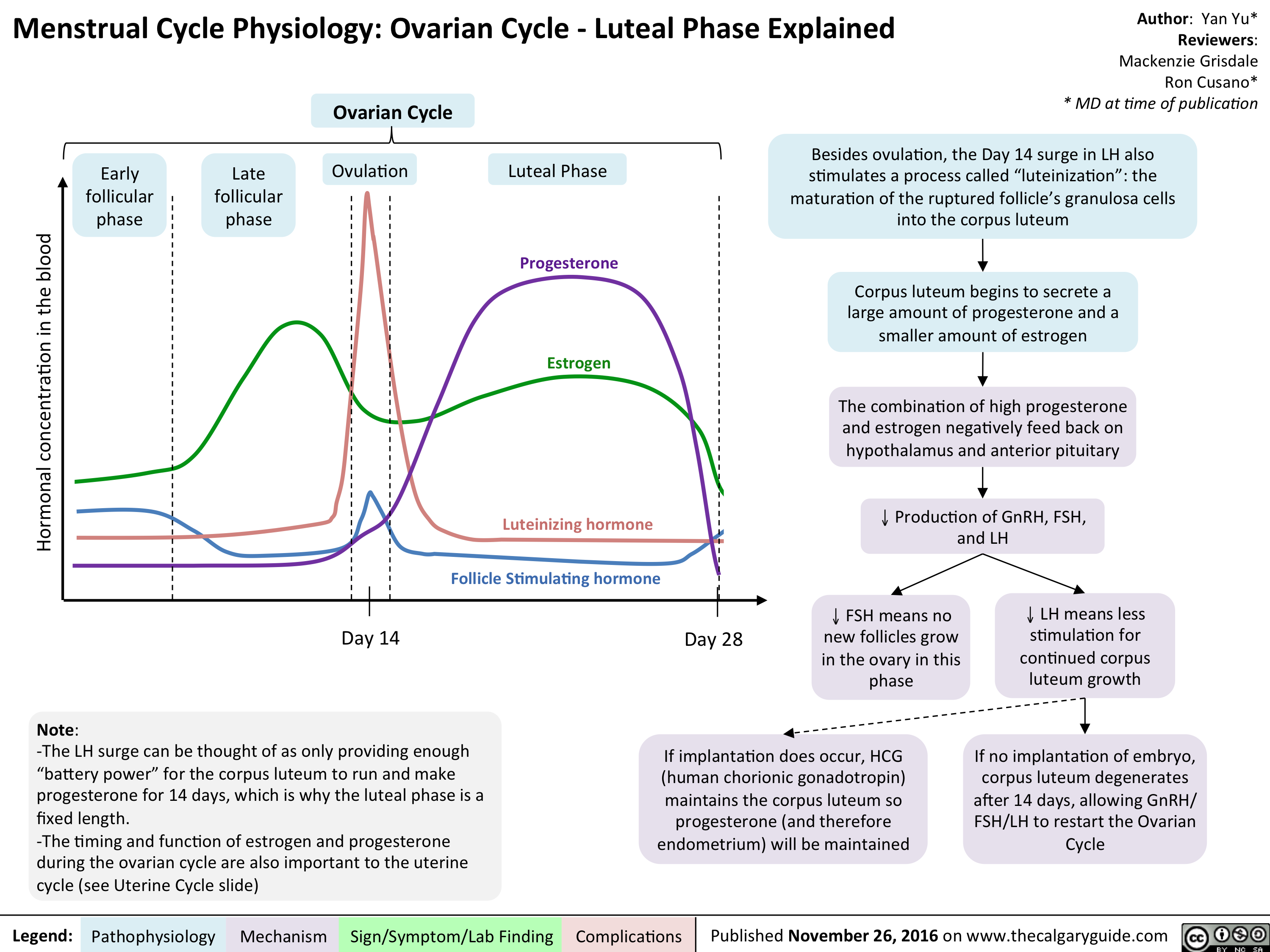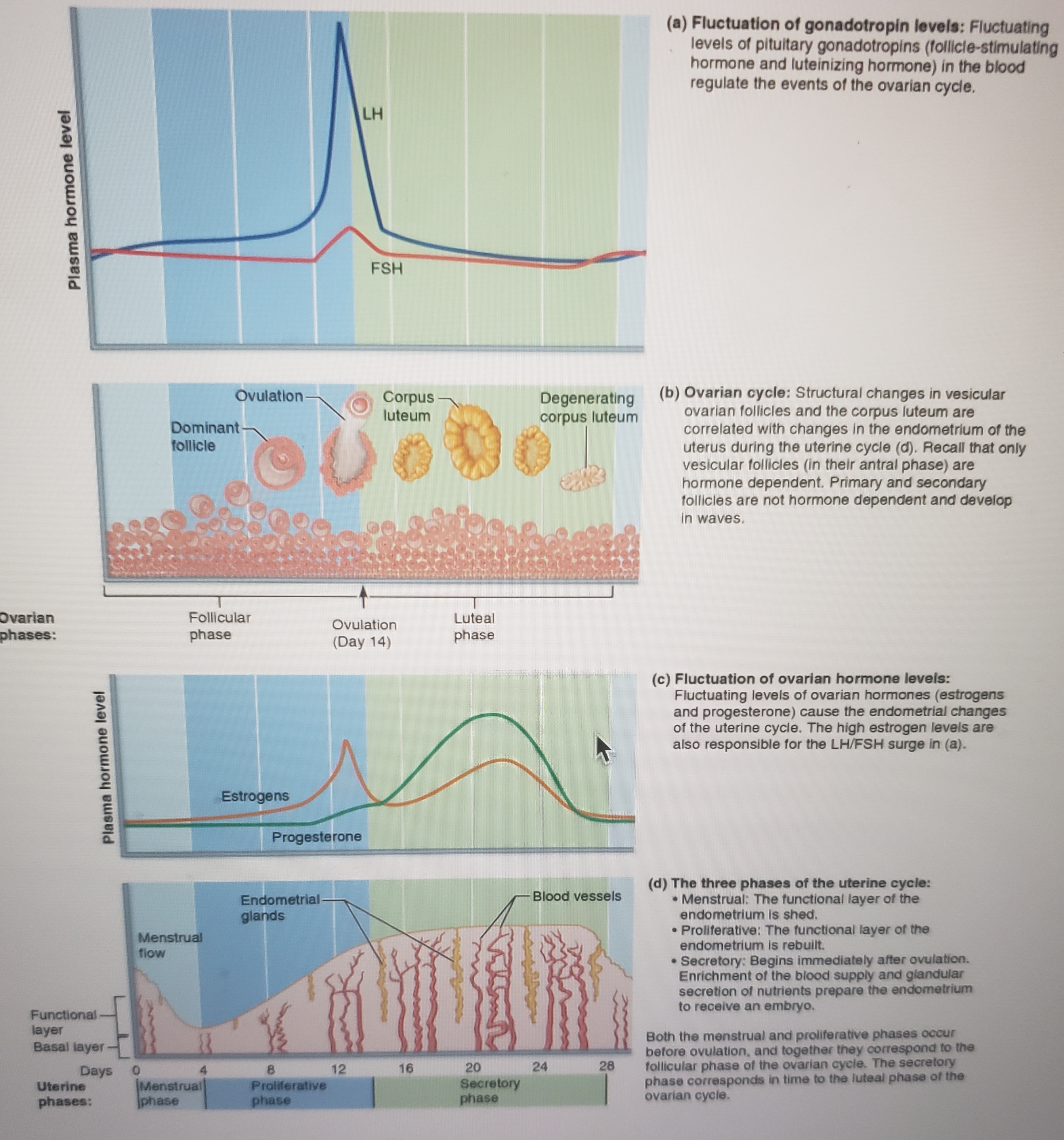Menstrual Cycle Physiology: Correlating the Ovarian
4.5 (261) In stock

Menstrual Cycle Physiology: Correlating the Ovarian and Uterine Cycles Note: Some charts show different relative levels of the gonadotropins (LH and FSH) to estrogen and progesterone, but the key is to compare the relative levels of estrogen with progesterone, and to observe how they change compared to the gonadotropins. Ovarian Cycle 1. Follicular phase (around 10-14 days long) • Starts at puberty (unclear mechanisms), 6-20 follicles re-activated per month. • One follicle outpaces the others, continues to develop into the mature follicle (others degenerate). • The process also involves hormones released by theca and granulosa cells (activin and inhibin) that affect follicle development as well. See also "Follicular Phase Explained" slide. 2. Ovulation • Release of secondary oocyte around day 14 (can vary) • Triggered mostly by LH surge. See also "Ovulation Explained" slide. 3. Luteal phase (always 14 days long) • Follows release of oocyte • Transformation of granulosa and theca cells of the follicle into the corpus luteum, which secretes progesterone and a bit of estrogen to negatively feed back on the anterior pituitary and inhibit the growth of new follicles. • Corpus luteum degenerates in 14 days if no fertilization (thus, luteal phase is always 14 days long). See also "Luteal Phase Explained" slide. Uterine Cycle: 1. Menses (menstrual bleeding) • Occurs during the first part of the follicular phase of the ovarian cycle due to the sharp decline in progesterone 2. Proliferative phase • Before and up to ovulation, the endometrium adds new cell layers, especially due to estrogen • During late proliferative phase: estrogen makes cervical mucous thinner, more abundant, and stringier, which allows it to be penetrated by sperm. 3. Secretory phase • Corpus luteum hormones, mostly progesterone, limit endometrial growth while endometrial secretions. • After ovulation, progesterone causes mucus to become thick and tacky, less likely to be penetrated by sperm. #UterineCycle #MenstrualCycle #OvarianCycle #pathophysiology #comparison #endocrinology

A Novel Study Suggests The Menstrual Cycle Might Literally Change The Brain

Menstrual Cycle- Definition, Hormones, Phases, Diagram

19 NP Cheat Sheets ideas nursing school tips, nursing students, nursing study

Menstrual Cycle (Ovarian and Uterine Cycles) - Physiology Flashcards
Figure Schematic And Microscopic Views Of The Ovarian Cycle 3717

The menstrual cycle. The pituitary and ovarian hormones regulating the

Introductory Chapter: Regulation of Ovarian-Menstrual Cycle as a Systemic Problem of Physiology of Humans

Menstrual Cycle Physiology: Ovarian Cycle – Luteal

Solved Consider Figure 27.25. 1. Why is it that estrogen
Luteal phase scenarios in ART. No corpus luteum (upper panel)
Menstrual Cycle Mapping Can Help You to Live Your Best Life
Energy Levels Through Your Menstrual Cycle
 Deago Nipple Covers Self Adhesive Strapless Backless Bra Lifting Push Up Sticky Bras For Swimming Wedding Party Evening Dress
Deago Nipple Covers Self Adhesive Strapless Backless Bra Lifting Push Up Sticky Bras For Swimming Wedding Party Evening Dress Women Fashion Butt Lifting Anti Cellulite Leggings High Waisted
Women Fashion Butt Lifting Anti Cellulite Leggings High Waisted Black beads bracelet on girl hand. Can be used as fashion
Black beads bracelet on girl hand. Can be used as fashion Wingslove Women's Strapless Longline Lace Bustier Corset Crop Bra Push Up Underwire Sexy Lace bra-Trim Low Back, White 36C
Wingslove Women's Strapless Longline Lace Bustier Corset Crop Bra Push Up Underwire Sexy Lace bra-Trim Low Back, White 36C/i.s3.glbimg.com/v1/AUTH_5dfbcf92c1a84b20a5da5024d398ff2f/internal_photos/bs/2022/7/T/k0EgGsT4KQ0ENz6yx0Ng/pfw-ss23-backstage-acielle-style-du-monde-dior-010.jpg) Renda é a tendência da vez no verão 2023, Moda
Renda é a tendência da vez no verão 2023, Moda Women - Most popular – Perfect Jeans
Women - Most popular – Perfect Jeans